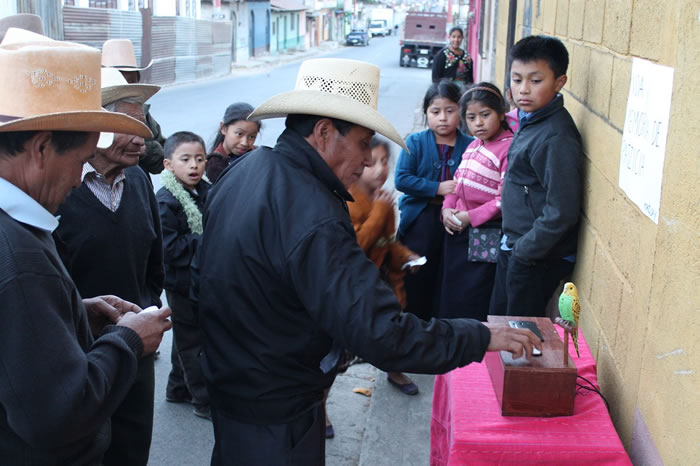artists AND RESEARCHERS from the new school AND guatemala rethink the past, reimagine the present after decades of VIOLENT conflict
|
NEW YORK, March 12, 2015 --Parsons' Sheila C. Johnson Design Center at The New School presents Guatemala Después: Rethinking The Past, Reimagining The Now, a joint exhibition by The New School and Ciudad de la Imaginación, a Guatemalan nonprofit contemporary arts institution, from April 10-29. The exhibition also will take place in Quetzaltenango, Guatemala in June 2015. For a list of public programs associated with Guatemala Despues, click here. The culmination of a yearlong collaboration between New School faculty and students and Guatemalan artists, scholars and thinkers, Guatemala Después comprises a series of collective projects that aim to rethink contested histories and injustices after decades of repression, violence and economic deprivation resulting from 36 years of armed conflict in Guatemala. The exhibition features works engaging the visual arts, sound, film, performance, interactive design and digital narratives. “Our goal is to provoke and transform the ways in which we understand historic memory, repression, healing and forms of utopia or dystopia emerging in Guatemala in the past three decades, and what is happening in response to that today,” said Nitin Sawhney, an assistant professor of media studies at The New School for Public Engagement and a co-curator of Guatemala Después. Beginning in 1960 and ending with peace accords in 1996, the so-called Guatemalan Civil War claimed over 200,000 lives, 83 percent of which were Mayan, according to a 1999 report written by the U.N.-backed Commission for Historical Clarification. The report also found that the vast majority of human rights violations were perpetrated by state forces and military groups backed by the United States and other Western governments. The projects in Guatemala Después were conceived through co-investigations, fieldwork, and interviews conducted in Guatemala since early 2014. A collective set of artistic investigations by 10 to 12 multidisciplinary teams of nearly 40 artists, social scientists, and community activists were selected for the exhibition, along with reference works by established artists, according to Anabella Acevedo, executive director of Ciudad de la Imaginación and co-curator of Guatemala Después. The artists include Benvenuto Chavahay, Jessica Kairé and Regina José Galindo. Some of the artistic projects conduct a re-reading of history through different, formerly suppressed memories. Vida y Memoria situates itself in an indigenous village in the region of Patzicía to revisit armed conflict from the community’s point of view; Justa memoria explores the topic of reconciliation while interviewing Guatemalans closely connected toexhumations of family members lost through forced disappearances; Puntos co-existentes reveals the voices of different artists who created works during the war; and Placeres Subterráneos seeks to visualize political repression and the absence of recognition of violence against homosexuals. Others projects examine the social fabric of Guatemala’s contemporaneity. Sitio Seña, a textile collective, approaches the experience of migration through the symbolic; Hipnosis engages public performance in city buses and other public spaces to comment on violence against women in an ironic and popular manner; ¿Me escuchas? explores transnational experiences of Guatemala through virtual dialogue; La metamorfosis de la devaluación uses currency devaluation to reflect on migration and transnational relations; and ¿Guatemala después? reflects on history from personal and fragmented memories in and outside the country. A third group of artistic works generates new narratives of the past. El olvido que no sabe que es olvido proposes re-readings of the armed conflict through epigraphic writings; and Saturno: año 174 takes Saturnian time as a reference for lived history in Guatemala, condensing our perception of historic narratives reframed concurrently in an alternative temporal and cognitive dimension. “The project is trying to do many things: To open new spaces to showcase contemporary art from Guatemala, to build international networks that connect artists of different countries, and to address issues dealing with Guatemalan and Latin American society,” said Pablo José Ramírez, co-curator of Guatemala Después. “These artists are critical mirrors of the reality of the country.” Radhika Subramaniam, director and chief curator of the SJDC, said the exhibition “reflects SJDC’s ongoing commitment to experimental pedagogies that connect us politically and historically to the rest of the world.” Learn more about Guatemala Después on their website and Kickstarter page. Of related interest in New York is EFA Project Space’s exhibition curated by Emiliano Valdés opening on April 10. |
|
The Sheila C. Johnson Design Center is an award-winning campus center for Parsons The New School for Design that combines learning and public spaces with exhibition galleries to provide an important new downtown destination for art and design programming. The mission of the Center is to generate an active dialogue on the role of innovative art and design in responding to the contemporary world. Its programming encourages an interdisciplinary examination of possibility and process, linking the university to local and global debates. The center is named in honor of its primary benefactor, New School Trustee and Parsons Board of Governors Member Sheila C. Johnson. The design by Rice+Lipka Architects is the recipient of numerous awards, including an Honor Award from the American Institute of Architects. For more information please visit www.newschool.edu/sjdc. Parsons School of Design is one of the leading institutions for art and design education in the world. Based in New York but active around the world, the school offers undergraduate and graduate programs in the full spectrum of art and design disciplines. Critical thinking and collaboration are at the heart of a Parsons education. Parsons graduates are leaders in their respective fields, with a shared commitment to creatively and critically addressing the complexities of life in the 21st century. For more information, please visit www.newschool.edu/parsons. |
 |
MARKETING AND COMMUNICATION |
| 79 Fifth Avenue New York, NY 10003 www.newschool.edu |
PRESS RELEASE |
Media Contacts: Scott Gargan, |
|
|
